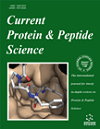- Home
- A-Z Publications
- Current Protein and Peptide Science
- Previous Issues
- Volume 25, Issue 3, 2024
Current Protein and Peptide Science - Volume 25, Issue 3, 2024
Volume 25, Issue 3, 2024
-
-
Soluble Factors Associated with Denervation-induced Skeletal Muscle Atrophy
More LessAuthors: Marianny P. Rodríguez and Claudio Cabello-VerrugioSkeletal muscle tissue has the critical function of mechanical support protecting the body. In addition, its functions are strongly influenced by the balanced synthesis and degradation processes of structural and regulatory proteins. The inhibition of protein synthesis and/or the activation of catabolism generally determines a pathological state or condition called muscle atrophy, a reduction in muscle mass that results in parti Read More
-
-
-
Diabetic Wound: Pathophysiology, Complications and Treatment Strategies
More LessAuthors: Sunita Chauhan, Monika Gulia, Rahul P. Singh and Vikas JhawatDiabetic wound healing is expected to affect 25% of all diabetics, resulting in less severe external factors, economic costs, and less trauma. Topical formulations have been continually improved to achieve a range of amazing properties and have had a significant impact on the management of diabetic wounds. Topical insulin has become one of the most attractive and convenient wound healing techniques due to its excellent bio Read More
-
-
-
Bile Acids as Signaling Molecules: Role of Ursodeoxycholic Acid in Cholestatic Liver Disease
More LessAuthors: Eduardo Cifuentes-Silva and Claudio Cabello-VerrugioUrsodeoxycholic acid (UDCA) is a natural substance physiologically produced in the liver. Initially used to dissolve gallstones, it is now successfully used in treating primary biliary cirrhosis and as adjuvant therapy for various hepatobiliary cholestatic diseases. However, the mechanisms underlying its beneficial effects still need to be clarified. Evidence suggests three mechanisms of action for UDCA that could benefit hum Read More
-
-
-
Emerging Role of Non-collagenous Bone Proteins as Osteokines in Extraosseous Tissues
More LessAuthors: Kenda Jawich, Rana Hadakie, Souhaib Jamal, Rana Habeeb, Sahar Al Fahoum, Alberto Ferlin and Luca De ToniBone is a unique tissue, composed of various types of cells embedded in a calcified extracellular matrix (ECM), whose dynamic structure consists of organic and inorganic compounds produced by bone cells. The main inorganic component is represented by hydroxyapatite, whilst the organic ECM is primarily made up of type I collagen and non-collagenous proteins. These proteins play an important role in bone homeostasis, calciu Read More
-
-
-
Bioconjugation Techniques for Enhancing Stability and Targeting Efficiency of Protein and Peptide Therapeutics
More LessAuthors: Tanuja Bisht, Anupriya Adhikari, Shivanand Patil and Shivang DhoundiyalBioconjugation techniques have emerged as powerful tools for enhancing the stability and targeting efficiency of protein and peptide therapeutics. This review provides a comprehensive analysis of the various bioconjugation strategies employed in the field. The introduction highlights the significance of bioconjugation techniques in addressing stability and targeting challenges associated with protein and peptide-based dru Read More
-
-
-
Biological Significance of EphB4 Expression in Cancer
More LessEph receptors and their Eph receptor-interacting (ephrin) ligands comprise a vital cell communication system with several functions. In cancer cells, there was evidence of bilateral Eph receptor signaling with both tumor-suppressing and tumor-promoting actions. As a member of the Eph receptor family, EphB4 has been linked to tumor angiogenesis, growth, and metastasis, which makes it a viable and desirable target for drug dev Read More
-
-
-
Design and Simulation of the Microcantilever Biosensor for MITF Antigen and D5 Monoclonal Antibody Interaction Finite Element Analysis, and Experimental
More LessAuthors: Pelin Akcali, Kübra Kelleci and Sevil OzerBackground: Biosensors and MEMS have witnessed rapid development and enormous interest over the past decades. Constant advancement in diagnostic, medical, and chemical applications has been demonstrated in several platforms and tools. In this study, the analytical and FEA of the microcantilever used in biomolecular analyses were compared with the experimental analysis results. Methods: In this study, MITF antig Read More
-
Volumes & issues
-
Volume 26 (2025)
-
Volume 25 (2024)
-
Volume 24 (2023)
-
Volume 23 (2022)
-
Volume 22 (2021)
-
Volume 21 (2020)
-
Volume 20 (2019)
-
Volume 19 (2018)
-
Volume 18 (2017)
-
Volume 17 (2016)
-
Volume 16 (2015)
-
Volume 15 (2014)
-
Volume 14 (2013)
-
Volume 13 (2012)
-
Volume 12 (2011)
-
Volume 11 (2010)
-
Volume 10 (2009)
-
Volume 9 (2008)
-
Volume 8 (2007)
-
Volume 7 (2006)
-
Volume 6 (2005)
-
Volume 5 (2004)
-
Volume 4 (2003)
-
Volume 3 (2002)
-
Volume 2 (2001)
-
Volume 1 (2000)
Most Read This Month
Article
content/journals/cpps
Journal
10
5
false
en


